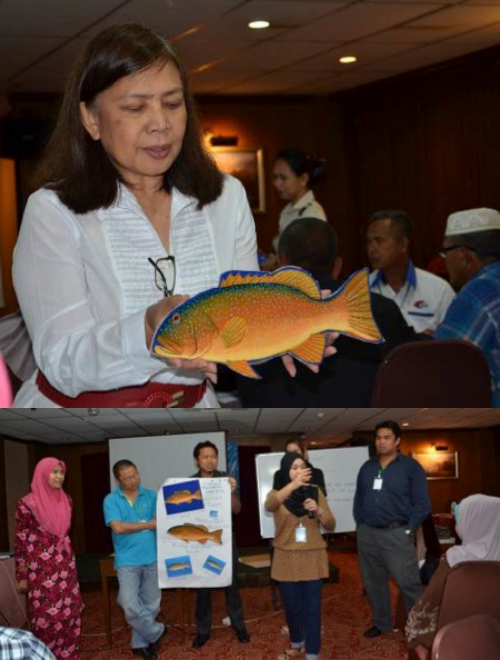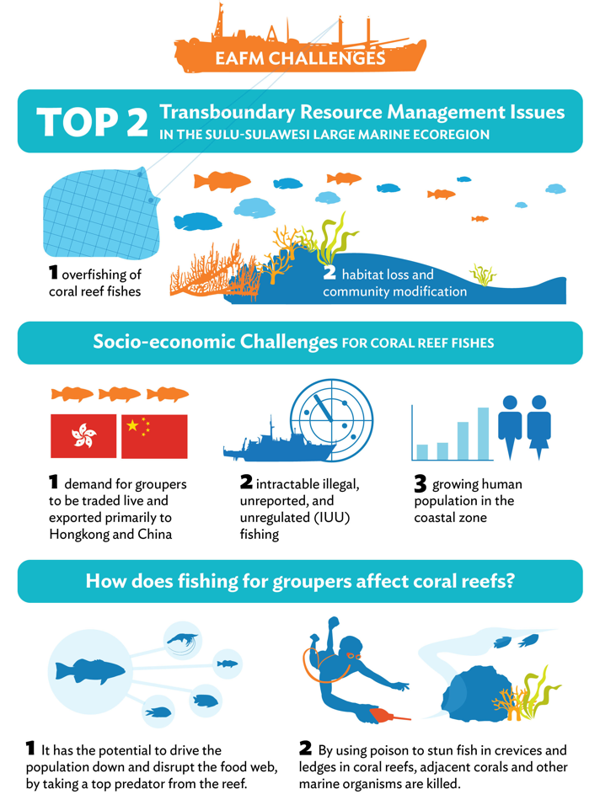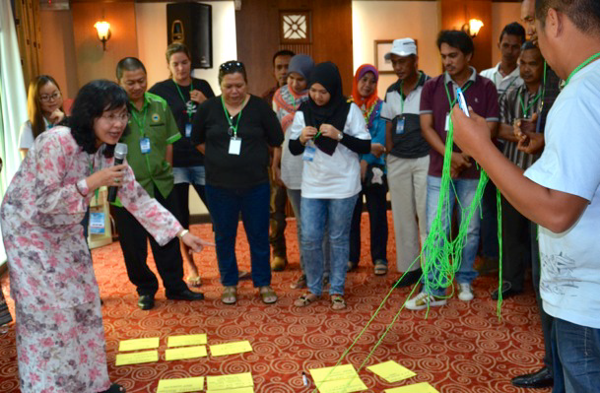
Building Knowhow on the Application of the Ecosystem Approach to Fisheries Management in Sabah
The ADB /GEF-supported Regional Technical Assistance for Coastal and Marine Resources Management in the Coral Triangle - Southeast Asia (CTI-SEA) is being implemented in the Sulu-Celebes/Sulawesi Large Marine Ecosystem, which includes Indonesia, Malaysia, and the Philippines (CT3). Experts from the CT3 have identified overexploitation of marine resources and habitat loss among the key problems in transboundary waters. Specifically, the coral reef fisheries in the region have been adversely affected by the high demand for live grouper; rampant illegal, unreported, and unregulated (IUU) fishing; and the rapidly growing population in coastal areas.
To address these critical issues, the CTI-SEA has taken steps to address IUU fishing at both the regional and national levels. In Malaysia, the project is building the capacity of government staff and other concerned stakeholders on the application of the ecosystem approach to fisheries management (EAFM) for coral reef fishes. This is done through a three-pronged approach that involves EAFM training for Malaysian fisheries officers and other stakeholders, a study tour, and a study on the live reef food fish trade (LRFFT) in Semporna. This activity is being implemented in close coordination with the Department of Fisheries (DOF) Sabah, the management authority. Using the Essential EAFM manual developed through the Bay of Bengal Large Marine Ecosystem Project funded by GEF and the Food and Agriculture Organization (FAO), CTI-SEA has trained 56 fisheries officers and concerned stakeholders from Sabah and other states of Malaysia, thus increasing the national capacity in EAFM application in the country.
Overfishing of coral reef fishes, habitat loss, and community modification are the top transboundary resource management problems in the Sulu-Sulawesi large marine ecosystem. There are three main socioeconomic drivers for the overexploitation of coral reef fishes including:
- The demand for live groupers for export primarily to Hong Kong and China;
- Illegal, unreported, and unregulated (IUU) fishing which is hard to control; and
- The rapidly growing human population in the coastal zone.
IUU fishing of coral reef fishes includes:
- The use of destructive chemicals, such as cyanide and chlorine, fish bombs, and gill-nets with less than 2 cm mesh size;
- Failure to report fish catch sold in domestic or international markets; and
- Absence of regulations on the amount of catch or the size of the fish or trade, such as transboundary, in the high seas.
Fishing for reef fishes is destructive because it takes out top predators from the coral reefs. This results to the disruption of the
food web and it also drives the population (stock) down. Second, by using poison to stun fish in crevices and ledges in coral reefs, corals and other marine organisms in the area are killed (see Fig. 2). These transboundary problems and associated issues have plagued the management of live reef food fisheries trade since the 1980s. Non-government organizations such as the World Wide Fund for Nature (WWF) and the International Union for the Conservation of Nature, as well as the CT3 governments, have carried out various steps to address these problems which persisted despite the issuance of policies like the CTI-wide agreement to address IUU fishing in the live reef fish food trade.
| Meta data | |
|---|---|
| Regions | Asia , South-Eastern Asia |
| Scope | Regional |
| Ecosystem | LME |
| Categories | Large Marine Ecosystem |
CTI-SEA has a regional subproject to address IUU fishing of coral reef fishes in the Sulu-Sulawesi Seascape, which will require the collaboration and cooperation of the CT3 countries. It focuses on the export of live groupers and wrasse (mameng) from Palawan to Malaysia, China, Hong Kong, trading of these fishes at sea in Kwandang, Semporna, Sandakan, the failure to report the catch when traded at sea, and poaching by foreign vessels. The CT3 countries have yet to agree on how to address the illegal transboundary trade and poaching issues.
At the national level, monitoring, control, and surveillance (MCS) training will be given to marine park rangers in Malaysia. A study will be carried out to determine how to implement MCS in Sulawesi, Indonesia and Palawan, Philippines. One of the focal areas of the Malaysia component of CTI-SEA is capacity building in EAFM through a three-pronged approach made up of:
- Delivering training on EAFM to impart knowledge to fisheries officers and other stakeholders (Fig. 3);
- Organizing a study tour for fisheries officers and fishers to expose them to EAFM issues and solutions in other countries; and
- Providing experiential learning in the application of EAFM for coral reef fisheries, including the harvest of live groupers, in the coral reefs of Semporna, Sabah.
The conduct of EAFM training in close partnership with the government fisheries agency (DOF Sabah and DOF Malaysia) was highly beneficial, not only in terms of the additional financial assistance provided, but also in building trust and confidence in collaborative work among stakeholders – a crucial element in the transboundary management of large marine ecosystems (Fig. 3). As a result, the project was able to train 56 fisheries officers and other stakeholders, almost double the target of 30, within six months of subproject implementation.
The arrangements for the training sessions were facilitated by the involvement of competent trainors who have been received prior training from the BOBLME Project, an existing training manual on Essential EAFM that was developed by an earlier project (GEF ID 1252), easy identification of trainees through close collaboration with DOF Sabah and DOF Malaysia, and the willingness of DOF Malaysia to provide co-financing to support the participation of additional fisheries officers from other states of Malaysia in the EAFM training that was originally planned only for DOF Sabah stakeholders.
The excellent collaboration between CTI-SEA and the Government of Malaysia, through DOF Sabah and DOF Malaysia, manifested through technical cooperation and financial support, enabled the training of 56 fisheries officers and other stakeholders, who will be able to apply EAFM to the management of nearshore fisheries in the country. This training activity, conducted in close partnership with DOF, showed that an investment of about US$20,000 can result in cost savings of US$15,000-17,000, the amount that would have been spent if training sessions were conducted separately for the 26 fisheries officers from outside Sabah.
Both the trainees and the trainors appreciated the benefits of the training course. Dr. Norasma Dacho, Head of the Conservation and Natural Resources Branch, DOF Sabah, and one of the trainors said, “The trainees’ suggestions on how to address the issues identified during their group work will be useful to the trainees when they implement the EAFM Plan.”
Mr. Al Amin bin Kassim, one of the trainees, thanked CTI SEA and DOF Malaysia for the opportunity to attend the training and said that he will gladly share what he learned with the other fishers in Semporna. He also expressed the hope that similar trainings could be conducted in the future and include more fishers like him.
The strategy pursued by CTI-SEA in this subproject worked well because of the strong political commitment of the Government to the new paradigm on fisheries management and socioeconomic development. Malaysia was the Chair of the CTI-CFF EAFM Technical Working Group (TWG) until 2014.
Through the National Oceanography Directorate (NOD) of the Ministry of Science, Technology, and Innovation (MOSTI), funds were allocated for CTI-related activities in Sabah. That budget subsidized the cost of the two training sessions (by covering the honoraria of two trainers and providing some logistics support), and DOF Malaysia funded the travel costs of 26 fisheries officers from Sarawak and Peninsular Malaysia.
CTI-SEA provided funding for two training sessions on EAFM for fisheries officers from Sandakan and industry stakeholders from Tawau. The subproject is considered significant for the following reasons:
- It was the first time that the three-day training on Essential EAFM for Stakeholders was held in Malaysia. The program was modified from a longer five-day training for executives and was translated to Bahasa Malaysia for easier understanding, particularly for the non-technical trainees.
- This was also the first Essential EAFM training to involve Malaysian fishermen following a step-bystep process in the Essential EAFM training manual developed by the Coral Triangle Consortium.
- The training was designed in such a way that it built trust and confidence in collaborative work among various stakeholders, which is essential for transboundary fisheries management in large marine ecosystems.
- The subproject also showed how one GEF project could contributed to the achievement of another GEF-funded project.
As a result, from the baseline in 2014, these two training sessions have increased the capacity of officers from 4 to 45, of tourism sector stakeholders from 0 to 3, of live reef fish traders from 0 to 1, and of fishers from 0 to 15. The trainees will be involved in the actual implementation of the ecosystem approach to coral reef fisheries management, particularly for groupers, which are exploited in the live reef fish trade and are viewed as a tourist attraction in the Semporna Priority Conservation Area of the SSME.
REFERENCES
FAO. Code of Conduct for Responsible Fisheries. http://www.fao.org
Coral Triangle Initiative on Coral Reefs, Fisheries, and Food Security (CTI-CFF). http://www.coraltriangleinitiative.org
Bay of Bengal Large Marine Ecosystem Project. Essential EAFM: Developing capacity in the ecosystems approach to fisheries management (EAFM).http://www.boblme.org/eafm/
Garcia, S. M., J. Rice, and A. Charles. 2010. Governance of marine fisheries and biodiversity conservation: Interaction and Coevolution. (1st ed.) John Wiley and Sons Ltd. 428 p.
- Guillermo L. Morales (glmorales@primexinc.org)

Image 1. One of the innovations during the second training was the exercise on data gathering

Image 2. Key challenges in coral reef fisheries and transboundary management

Image 3. Participants from Johor, Kedah, Perak, Pulau Pinang, Sarawak, Selangor, and Terengganu gave positive feedback on the EAFM training.

























